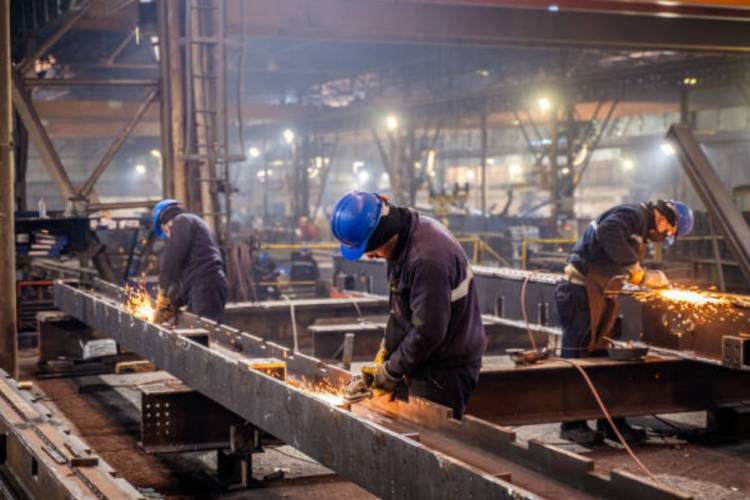India’s manufacturing sector, after years of middling performance, appears to have turned a corner—at least on the surface. New data from the Centre for Monitoring Indian Economy (CMIE) shows that in the first quarter of 2025, manufacturing accounted for 54% of new project announcements, amounting to Rs 2.3 trillion. This is the sector’s highest share in ten quarters and a rare occurrence since 2010. The sharp uptick has raised hopes of a revival in a sector that remains central to job creation, value addition, and GDP growth.
However, the recent surge may not yet mark a structural turnaround. There is a possibility that this is merely a seasonal uptick, driven by a handful of large-ticket announcements and pre-election budgetary stimuli. Still, the numbers are hard to ignore.
READ | Fake fertilisers threaten crop yields, food security
Sectoral momentum and large projects
In terms of value, metals and metal products led with 34.3% of new project announcements in Q1 FY25, followed by chemicals (8.3%) and machinery (3.5%). Vedanta’s Rs 1.2 trillion Dhenkanal aluminium smelter project—complete with a 4,900 MW captive power plant—was the most prominent. Deepak Nitrite’s Rs 3,500 crore facility for phenol, acetone, and isopropyl alcohol also reflects a renewed interest in high-value manufacturing.
This investment momentum is supported by data from the Reserve Bank of India’s OBICUS survey, which reported capacity utilisation at 75.4% in Q3 FY24, up from 74.2% in the previous quarter. At the same time, private sector capital expenditure in manufacturing reached Rs 60,000 crore in June 2024—evidence of rising demand and an uptick in confidence.
China-plus and policy catalysts
India’s manufacturing growth is also being shaped by global shifts. Western economies are actively diversifying supply chains away from China, presenting an opportunity India is beginning to seize. Higher capacity utilisation by Indian firms suggests they are not only meeting existing demand but also preparing to service more diversified global supply chains.
Domestically, policy initiatives are beginning to bear fruit. The Production-Linked Incentive (PLI) scheme continues to attract investment, with Rs 24,140 crore committed and Rs 21,534 crore disbursed across 12 sectors by March 2025. The Union Budget 2025-26 allocated Rs 2,500 crore for 12 plug-and-play industrial parks, further reducing entry barriers for investors. The Dedicated Freight Corridor (DFC), among other infrastructure upgrades, has improved logistics—a longstanding handicap for Indian industry.
Growth forecasts and sectoral prospects
Spherical Insights & Consulting estimates India’s manufacturing sector will grow from $1.41 trillion in 2024 to $2.98 trillion by 2035, clocking a compound annual growth rate (CAGR) of 7.04%. Pharmaceuticals and semiconductors are expected to outperform, with CAGRs of 11.26% and 12.30%, respectively.
This aligns with the government’s strategy of shifting away from low-value manufacturing to high-end sectors such as electronics, defense, auto components, and green technologies—areas where India’s cost competitiveness and improving quality standards are earning global attention.
Persistent challenges
Despite the upbeat data, structural challenges remain. The sector’s contribution to GDP remains under 15%, well short of the 25% target under the ‘Make in India’ initiative. The Index of Industrial Production (IIP) rose by just 1.2% in May 2025, a nine-month low, partly due to the early monsoon disrupting mining and power generation.
Moreover, the government’s restrictions on importing gold compounds and rare earth elements have hampered electronics manufacturing—ironically, one of the very sectors India is trying to promote through the PLI scheme. This raises questions about the coherence of trade and industrial policy.
Jobs, automation, and the youth factor
Manufacturing is expected to generate around 7.9 million non-farm jobs annually until 2030, a crucial metric given India’s youth unemployment rate exceeding 17%. However, the rise of the gig economy and automation casts doubt on the stability of these jobs. Capital expenditure must align with employment objectives if India is to translate investments into livelihoods.
Moreover, while capex is a necessary condition for growth, it is not sufficient. Addressing the quality of human capital, reducing regulatory complexity, and improving ease of doing business—especially for small and medium enterprises—are equally important.
Need for coherent industrial strategy
If manufacturing is to grow faster than the broader economy and raise its share in GDP, India must move beyond high tariffs and focus on enabling competitive domestic value addition. That requires easing access to critical raw materials, machinery, and components. Many sectors would benefit more from cheaper imports of intermediates than from protectionist duties.
The next wave of industrial growth will be mineral-intensive and sustainability-driven. Sectors such as renewable energy, electric vehicles, and electronics depend on critical minerals—many of which India currently imports. Turning the country into a net importer of these essential inputs runs counter to the self-reliance narrative and could prove self-defeating.
The latest data suggests that manufacturing is not in terminal decline. But nor is it in full recovery. The uptick in Q1 FY25 offers a window of opportunity, not a guarantee. Whether this is a true inflection point or a false dawn depends on policy consistency, investment in skills, integration with global value chains, and sustained infrastructure upgrades.
If India can address these issues with the urgency they deserve, the long-promised transformation of manufacturing from laggard to growth engine may finally materialise. Until then, cautious optimism remains the appropriate stance.

